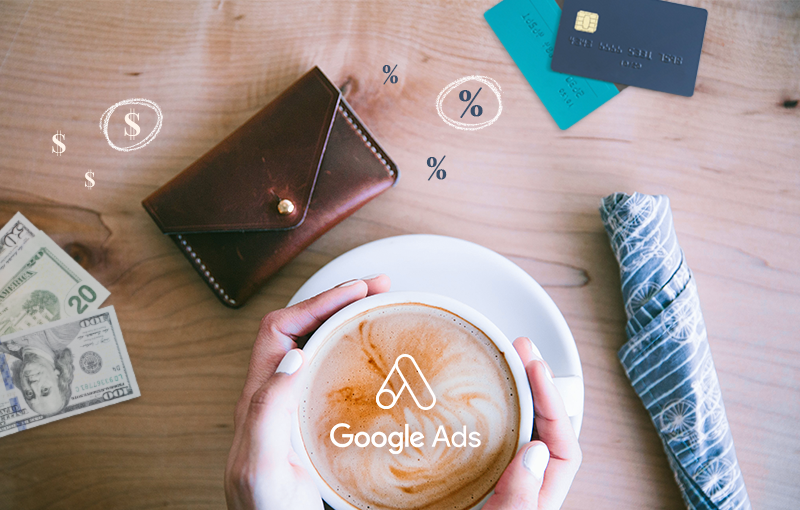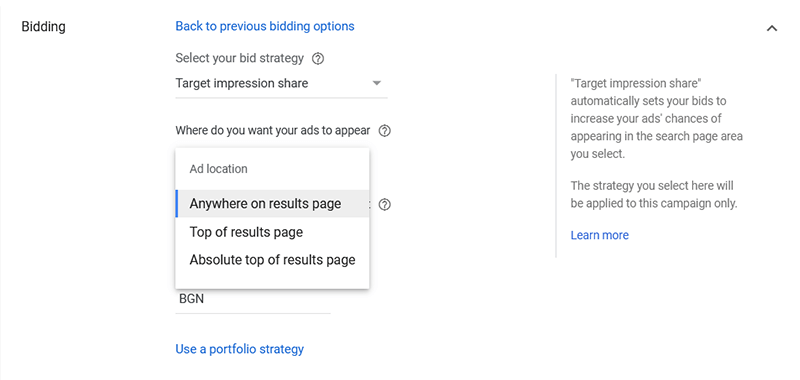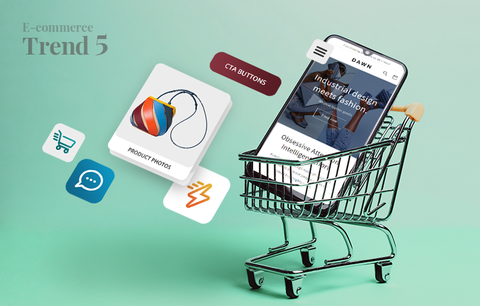
In the past months, we’ve talked a lot about Google Ads. We’ve tackled the basics and what you should do before you start advertising on Google. We’ve also discussed the most popular campaign types and how you can optimize your ads for mobile.
Jump to any guide:
- Getting Started With Google Ads
- Google Keyword Planner: How to Find the Keywords Your Customers Use?
- Mastering PPC: How to Create Successful Google Search Campaigns?
- Google Display Campaigns: Uncovering the Power of Remarketing
- Google Shopping in a Nutshell
- How to Create Mobile-Friendly Google Ads Campaigns?
Today, we’ll focus on Google Ads bidding. We’ll talk about the difference between manual, automated, and Smart Bidding. We’ll explain what you should factor in when choosing a bidding strategy. We’ll also have a closer look at the top 8 bidding strategies you should leverage.
Overview
Google Ads bidding
What is Google Ads bidding?
Google Ads runs an auction every single time it has an ad space available - on a search result, or on a blog, news site, or some other page. Each auction decides which ads will show at that moment in that space. Your bid puts you in the auction. (Source: Google, Understanding bidding basics)
Essentially, your bid tells Google how much you’re willing to pay for a click, conversion, impression, or view (for video ads only). Keep in mind that your bids should neither be too high (because you’re risking spending all your budget without achieving the desired results) nor too low (because this may lead to fewer impressions). The key to success is to find the balance and constantly adjust your bids based on different factors - from campaign type and budget to consumer behavior and seasonal trends.
Assessing all this is a time-consuming task that requires a high level of PPC expertise and a deep understanding of how Google Ads works. So, if you need help, you can always turn to a skilled Shopify Expert. But if you want to do it on your own, this guide will help you get started and understand the basics of Google Ads bidding.
There are several ways to bid for your ads - you can use manual, automated, or Smart Bidding, each consisting of different bidding strategies. Today, we’ll tackle 8 different bidding strategies: Manual CPC (Cost Per Click), 3 automated bidding strategies (Enhanced CPC, Maximize clicks, and Target Impression Share), and the 4 Smart Bidding strategies Google offers right now (Target CPA (Cost Per Action), Target ROAS (Return On Ad Spend), Maximize conversions, and Maximize conversion value). But first, let’s have a look at what you should factor in when choosing a bidding strategy.
How to choose the right Google Ads bidding strategy?
In terms of Google Ads success, choosing the right bidding strategy is just as important as targeting the right keywords and choosing the right campaign type. Why? Because choosing the right Google Ads bidding strategy will drive optimum results without putting a strain on your budget.
So, what do you need to take into account when choosing a bidding strategy?
First and foremost, your budget.
Second, but just as important, your business, marketing, and customer acquisition goals.
Third, the desired outcome of your campaign. For example, do you want to get more traffic to your Shopify store, raise brand awareness, or increase conversions? If you want to get more traffic, you should consider using Maximize clicks or Manual CPC. If you want to increase conversions, you should use Maximize conversions, Target CPA, or Target ROAS. And if you want to focus on the value of conversions, you should use Maximize conversion value.
Note: Aside from the desired outcome, you should also consider the type and volume of the campaign. Also, it is important to measure your campaign’s KPIs (Key Performance Indicators) to ensure the bidding strategy you’ve chosen works for you. If a campaign has been running for a few weeks and you’re unhappy with the results, consider changing the bidding strategy. Again, wait a few weeks to see how this affects the performance of the campaign - don’t jump to conclusions, as Google needs time to adjust and learn (usually, about a week). In other words, if a campaign is not performing as well as you’ve expected just a few days after you’ve adjusted your bids, it doesn’t necessarily mean that it won’t surpass your expectations in a week. So, be careful not to make any changes too early.
Now that you know what you need to take into account when choosing a bidding strategy, let’s move on to the next part of the article - manual bidding, what you should know about it, and how to use it.
Manual CPC (Cost Per Click)
Manual CPC lets you set and manage a maximum CPC for your ads. You can set a maximum CPC for an entire ad group, individual keywords, or placements. With manual CPC, you only pay when someone clicks on your ad (i.e., you don’t pay for impressions).
This bidding strategy gives you full control over the maximum amount you could pay for a click on your ads (as opposed to automated bid strategies, which automatically set and adjust your bids).
When setting a maximum CPC for a specific ad, you should consider the cost of the product you advertise - for example, you can set higher CPC for more expensive products (e.g., appliances, furniture, jewelry, etc.) and lower CPC for cheaper items (e.g., books, puzzles, etc.).
After you’ve set a maximum CPC, keep an eye on the performance of your campaign. It is important that you regularly evaluate your manual bids and adjust them to achieve the desired outcome.
So, let’s weigh in the pros and cons of Manual CPC. On the one hand, you have full control over your bids - you set your bids, and you’re the only one who can change them. On the other, setting your bids properly is time-consuming, requires PPC expertise, and a good understanding of how Google Ads works. In addition, Manual CPC doesn’t leverage Google’s machine learning capabilities to target customers who are more likely to convert. The key to success is to constantly review the performance of your campaigns and adjust your bids accordingly.
To select Manual CPC as a bid strategy, create a campaign > Select campaign settings > Bidding.
 Click “Or select a bid strategy directly (not recommended)” > Select your bid strategy > Manual bid strategies > Manual CPC.
Click “Or select a bid strategy directly (not recommended)” > Select your bid strategy > Manual bid strategies > Manual CPC.

Notice that the “Help increase conversions with Enhanced CPC” checkbox is marked by default. So, if you want to use Manual CPC, make sure to uncheck it.

↓

Keep learning → Manual CPC bidding & About Manual CPC bidding
Automated bidding
If you choose an automated bidding strategy, Google will automatically set and adjust your bids based on the likelihood that an impression will result in a click or a conversion. To achieve this, Google considers several factors, including the time of day and the searcher’s device, location, age, language, etc. As a result, you’re able to easily meet your performance goals.
Here’s what you need to know about automated bidding. Pros:
- Bids are set automatically, i.e., automated bidding is not as time-consuming as manual bidding. However, keep in mind that you still need to monitor the performance of your campaigns regularly.
- Bids are unique to each auction.
- Google uses past data to inform future bids and learns over time what works well for you and what doesn’t.
Cons:
- You have less control over how much you spend per click or conversion. In fact, you need to have a flexible advertising budget as there might be rapid fluctuations in the amount you pay for a single click.
- Automated bidding uses past data to adjust your bids and optimize for your goals. Therefore, if you’re just starting with Google Ads, you should consider using Manual CPC and moving on to automated bid strategies once you have gathered enough historical data.
Keep learning → About automated bidding
Now, let’s have a look at 3 popular automated bidding strategies: Enhanced CPC, Maximize clicks, and Target impression share.
Enhanced CPC (Cost Per Click)
You can think of Enhanced CPC as a helpful upgrade to Manual CPC. It is a mix of manual and automated bidding - you set your bids (for ad groups and keywords) manually, but Google automatically adjusts them to help you drive more conversions. In other words, if Google thinks a click is highly likely to result in a conversion, it will automatically increase your bid and vice versa. All you need to do is decide if you want to optimize for conversions or conversion value.
Note that in the past, Google could increase or decrease your bid by up to 30%. However, this is not the case anymore - now, there are no limitations (even though Google tries to keep your average CPC below the maximum CPC you’ve set). So, before choosing Enhanced CPC, keep in mind that you may notice some unexpected (and drastic) bid adjustments.
So, let’s weigh in the pros and cons of Enhanced CPC. On the one hand, it broadens your reach and usually leads to higher CTR (click-through rate) and CVR (conversion rate). Plus, you don’t need a breadth of historical data to use it. On the other hand, you have less control over your bids, so you may end up spending more than anticipated.
To sum up, Enhanced CPC is a great way to semi-automate the bidding process - this will save you time and may result in more conversions. However, if it isn’t properly set up, this bidding strategy may not be very profitable.
To set Enhanced CPC, set Manual CPC and leave the "Help increase conversions with Enhanced CPC" checkbox marked > Decide what you want to optimize for (i.e., conversions or conversion value) and mark the according checkbox.

Keep learning → About Enhanced CPC (ECPC)
Maximize clicks
Maximize clicks is an automated bidding strategy that aims to help you get the most clicks possible within your budget - basically, you set an average daily budget, and Google sets your bids to achieve the desired goal. Therefore, Maximize clicks is great for driving traffic to your Shopify store, raising brand awareness, and building a larger audience.
However, keep in mind that Google doesn’t take into account the quality or relevance of the traffic when optimizing your bids. Therefore, Maximize clicks is not a great choice if you want to increase sales. Still, if your Shopify store is optimized and you have a solid conversion funnel in place, some of the traffic this bidding strategy brings you will still result in conversions.
To set maximize clicks, create a campaign > Select campaign settings > Bidding > Click "Or select a bid strategy directly (not recommended)" > Select your bid strategy > Automated bid strategies > Maximize clicks.

Pro tip: If you decide to use Maximize clicks, always set a maximum CPC (Cost Per Click) and keep an eye on the performance of your campaigns. To set a maximum cost per click bid limit, mark the "Set a maximum cost per click bid limit" checkbox > Set a maximum CPC bid limit.

↓

Maximize clicks is available as a single campaign strategy or a portfolio strategy across multiple campaigns, ad groups, and keywords. Keep learning → About Maximize clicks bidding
Target impression share is a bidding strategy that helps you reach as many people as possible. As a result, it is perfect for increasing your visibility and raising brand awareness.
Target impression share automatically sets your bids so that your ad appears on the first page of the SERPs. You have three ad placement options: Absolute Top of Page (#1 spot), Top of Page, and Anywhere on the Page. Once you’ve chosen a placement option, Google uses your preferences to adjust your bids. Note: You can set a goal impression share percentage the same way you set a Target CPA (Cost Per Action).
Essentially, Target impression share aims to get your ad to appear exactly where you want. It is the perfect strategy for bidding on branded keywords (in this way, it will drive more relevant traffic to your Shopify store). However, it must be used with caution, as it can increase your bids beyond profitability. To avoid this, always set a maximum CPC bid.
To set Target impression share, create a campaign > Select campaign settings > Bidding > Click "Or select a bid strategy directly (not recommended)" > Select your bid strategy > Automated bid strategies > Target impression share.

↓

Select an ad placement option from the “Where do you want your ads to appear” dropdown.

Set a percentage impression share to target > Set a maximum CPC to avoid overspending. Learn more → About Target impression share bidding
Smart Bidding
Smart Bidding is a subset of automated bidding. Smart Bidding strategies use Google’s machine learning to optimize your bids for conversions or conversion value. How? By analyzing a wide range of auction-time signals (e.g., time of day, operating system, device, location, language, etc.) and adjusting your bids accordingly, i.e., if a user is more likely to buy from you, Google will increase your bid and vice versa.
Let’s weigh in the pros and cons of Smart Bidding. Pros:
- Smart Bidding strategies use machine learning. This means they use contextual signals and data to optimize your bids, giving you more time to focus on other important aspects of campaign setup.
- Smart Bidding strategies have a higher ROI (Return On Investment) potential than automated and manual bidding strategies.
- You have access to transparent performance reporting.
However:
- You lack visibility and have no control over the data Google uses to adjust your bids. Also, the data reflects a broader audience, not necessarily your target audience.
- You don’t have full control over your budget.
- For optimum results, it is best to have conversion history before using Smart Bidding.
Currently, there are four Smart Bidding strategies: Target CPA (Cost Per Action), Target ROAS (Return On Ad Spend), Maximize conversions, and Maximize conversion value. Before we have a closer look at each of these strategies, let’s have a quick overview of the best practices in terms of Smart Bidding:
- Simplify your account structure - this will allow you to easily make changes to your bidding strategies if necessary.
- Set up conversion tracking properly. Since Smart Bidding strategies are conversion-based, you must enable conversion tracking in order to use them. Also, Google recommends that you have at least 30 conversions in the past 30 days before using Target CPA and at least 50 conversions before using Target ROAS.
- Consider your goals when choosing a Smart Bidding strategy.
- Set clear and attainable goals for your Smart Bidding campaigns.
- Evaluate the performance of your ads regularly - don’t leave anything on autopilot.
- Once you’ve chosen a Smart Bidding strategy, give Google time to learn before assessing the results - the algorithm needs about a week to learn how to use and optimize your budget. Also, there are other factors you need to consider - e.g., seasonal trends and conversion lag time. So, be patient and don’t be too quick to draw conclusions and make changes.

Image source: Google, Get more value for less effort with Google Ads Smart Bidding, p 8.
- Last but not least, follow Google Ads best practices and ensure to comply with their advertising policies.
Target CPA (Cost Per Action)
Target CPA automatically sets your bids to get as many conversions as possible within your CPA goal - the amount of money you’re willing to pay for a conversion (i.e., Your CPA = Ad spend ÷ Conversions). Essentially, Target CPA uses contextual data to determine the likelihood of a conversion and avoid unprofitable clicks. It also aims to get you more conversions at a lower cost, which is great.
Note that individual conversions may cost more or less than the CPA you’ve set. Over time, Google will balance things out, and you won’t end up spending more than your average CPA for a conversion. You can set bid limits (minimum and maximum) if you want to have more control over bid adjustments.
However, there are some restrictions. For example, Target CPA can’t be used for Shopping campaigns. Also, it doesn’t allow you to separate bids for the Display network and the Search network.
Also, it is a good practice to use Target CPA after you’ve established a profitable CPA for your business. Otherwise, you may end up spending all your budget without achieving the desired results. To get this information, you may need to run campaigns that use Manual CPC or Enhanced CPC (before running campaigns that use Target CPA).
Last but not least, keep in mind that Target CPA requires a flexible and healthy budget. And remember Google’s recommendation - before using Target CPA, you should have at least 30 conversions in the past 30 days.
To set target CPA, create a campaign > Select campaign settings > Bidding > Click "Or select a bid strategy directly (not recommended)" > Select your bid strategy > Automated bid strategies > Target CPA > Set your target CPA.

↓

Note: If you decide to lower your Target CPA, you should make bite-sized drops. Google’s recommendation is to lower your Target CPA by 5-10% max (after your campaign has been running for at least one month). Then, you need to monitor the performance of your campaign for (at least) another month and decide if you can drop your Target CPA by another 5-10%.
You can use Target CPA for individual campaigns or as a portfolio strategy across multiple campaigns. Learn more → About Target CPA bidding
Target ROAS (Return On Ad Spend)
If you use Target ROAS, Google will set your bids to maximize conversion value based on the return on ad spend you want to get. ROAS is the average conversion value you receive in return for every dollar spent on your ads. This number is percentage-based: Target ROAS = Sales ÷ Ad spend x 100. For example, if you want a 10 x ROAS and spend $2 per click, you’re expecting $20 in return. This means that you should set your Target ROAS as 1000%.
How does Target ROAS work? Similar to Target CPA, Google uses historical data and analyzes contextual signals to predict the possibility of conversions. Then, it adjusts your bids to maximize conversion value while trying to achieve your Target ROAS. Individual conversions may have higher or lower ROAS than your Target ROAS, but Google will balance things out in the long term. Again, if you want to have more control over bid adjustments, you can set bid limits at the campaign or portfolio level.
Ultimately, Target ROAS aims to get your ads in front of the eyes of customers who’ll be warmer to your offer. It is the perfect strategy if you want to drive high-quality conversions. Remember that, to use Target ROAS, you’ll need more historical data - the minimum requirement is 15 conversions in the last 30 days for Search and Display campaigns and 20 conversions in the last 45 days for Shopping campaigns. However, Google recommends having at least 50 conversions in the past 30 days (compared to only 30 conversions for Target CPA).
To set Target ROAS, create a campaign > Select campaign settings > Bidding > Click "Or select a bid strategy directly (not recommended)" > Select your bid strategy > Automated bid strategies > Target ROAS > Set your target ROAS.

↓

Target ROAS is available as a portfolio bid strategy and a standard strategy for individual campaigns.
Learn more → About Target ROAS bidding
Maximize conversions
If you use Maximize conversions, Google will automatically set your bids to get as many conversions as possible within your daily budget. Since Google will aim to spend the entire allotted daily budget, each campaign using Maximize conversions should have its own budget and not be a part of a shared budget.
Similar to all other Smart Bidding strategies, Google uses machine learning and analyzes auction-time signals in real time to adjust your bids and achieve optimum results. All you need to do is set a daily budget you’re comfortable spending. For better results, it is preferred that you have some conversion data in place, but it is not required.
To set Maximize conversions, create a campaign > Select campaign settings > Bidding > Click "Or select a bid strategy directly (not recommended)" > Select your bid strategy > Automated bid strategies > Maximize conversions.

↓
 You can use Maximize conversions for individual campaigns but not as a portfolio bid strategy. Learn more → About Maximize conversions bidding
You can use Maximize conversions for individual campaigns but not as a portfolio bid strategy. Learn more → About Maximize conversions bidding
Maximize conversion value
Maximize conversion value works in a similar way to Target ROAS - you optimize for conversion value, but in this case, you choose to spend your entire budget instead of targeting a specific ROAS. However, if you wish, you can set one.
In other words, Google uses machine learning and analyzes auction-time signals to give you the most conversion value within your budget.
To set Maximize conversion value, create a campaign > Select campaign settings > Bidding > Click "Or select a bid strategy directly (not recommended)" > Select your bid strategy > Automated bid strategies > Maximize conversion value.

↓

Learn more → About Maximize conversion value bidding
Conclusion
Google Ads bidding is a complex topic - setting your bids properly requires a high level of PPC expertise and a deep understanding of how Google Ads works. If you don’t have the time or the expertise, you should consider working with a certified Shopify Expert.
However, if you want to do it on your own, this guide will give you the basics and help you get started. We talked about Google Ads bidding and how you can choose the right bidding strategy for your business. We also took a closer look at Manual CPC, 3 automated bidding strategies (Enhanced CPC, Maximize clicks, and Target impression share), and 4 Smart Bidding strategies (Target CPA, Target ROAS, Maximize conversions, and Maximize conversion value). We explained how each strategy works and how it can help you achieve your business, marketing, or customer acquisition goals.
If you have further questions or want to share your own experience, just leave a comment below!



